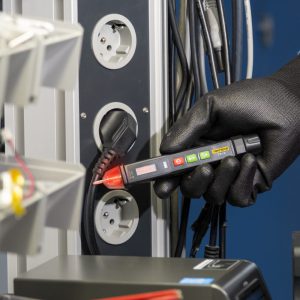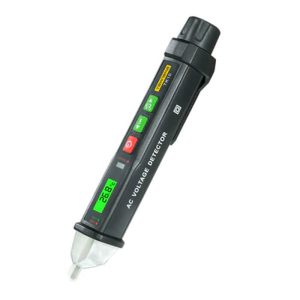Are you trying to find a non-contact method to check for the existence of AC voltage in wires, outlets, switches, circuit breakers, and other electrical devices? In that case, you may want to think about purchasing a non-contact voltage tester.
A non-contact voltage tester is a tool that can measure AC voltage without actually touching the electrical circuit, lowering the chance of electric shock and injury.
Non-contact voltage testers come extremely handy for a number of tasks, including inspecting a new home’s wiring, troubleshooting a broken appliance, confirming a device’s power supply, and more.
Depending on your needs and preferences, non-contact voltage testers are available in a variety of sizes, forms, and functions.
Table of Contents
ToggleIn this post, we’ll contrast two well-liked non-contact voltage tester models:
the Chauvin Arnoux C.A 732 Non-contact voltage tester and the Tekneka TK10 AC Voltage Detector. We’ll examine their features, attributes, benefits, and drawbacks to help you choose which is best for your applications.
You can check the AC voltage in wires, outlets, switches, circuit breakers, and other electrical devices without touching them by using non-contact voltage testers. By doing this, you can lower your risk of electric shock and prevent circuit damage.
Non-contact voltage testers come extremely handy for a number of tasks, including inspecting a new home’s wiring, troubleshooting a broken appliance, confirming a device’s power supply, and more. Non-contact voltage testers vary, though, so be sure to shop around.
You should think about their many features, characteristics, benefits, and drawbacks before making a purchase. In this post, we’ll contrast two well-liked non-contact voltage tester models: the Chauvin Arnoux C.A 732 Non-contact voltage tester and the Tekneka TK10 AC Voltage Detector.
We’ll examine their features, attributes, benefits, and drawbacks to help you choose which is best for your applications.
The pen-shaped Tekneka TK10 AC Voltage Detector can detect AC voltage between 12 and 1000 VAC without making metallic contact.
An audio alert and a red LED on it serve as voltage indicators. For use in dim areas, it also contains an integrated white LED illumination. Simply press the power switch while holding the device close to the electrical source you want to test.
The buzzer will sound and the red LED will flash if there is voltage. Additionally, the device has a low battery indicator that beeps and flashes the green LED three times before automatically shutting off.
Two 1.5 V AAA batteries (not supplied) are used to power the device, and their continuous use time is up to 200 hours. The device is 156 x 23 x 26 mm and has a CAT III 1000 V safety rating. It is 35 g heavy.
The following are some advantages of the Tekneka TK10 AC Voltage Detector:
It is capable of detecting a wide range of voltages under various circumstances, from low to high.
It clearly displays and audibly signals the presence of electricity.
It contains white LED lighting, which helps improve your night vision.
A low battery warning lets you know when the batteries need to be changed.
Its pen-like size and clip make it convenient to carry about and store.
The following are some of the Tekneka TK10 AC Voltage Detector’s shortcomings:
Because it runs on batteries, you must regularly purchase and replace them.
It lacks a phase identification feature that would enable you to determine whether a wire is live or neutral.
It lacks an integrated torch that can be used as a flashlight in low light.
Another pen-shaped instrument that can measure AC voltage between 195 and 265 VAC without metallic contact is the Chauvin Arnoux C.A 732 Non-Contact Voltage Tester. It contains an internal torch that can be used in low-light conditions.
Additionally, it has a phase identification feature that illuminates the instrument’s tip when a voltage of 230 V AC – 50/60 Hz is present. Simply press the power switch while holding the device close to the electrical source you want to test.
The buzzer will sound and the instrument’s tip will light up if there is voltage present. The device also includes a multilayer insulation that guards against damage and electric shock. The gadget is 35 x 145 x 285 mm and has a CAT III 1000 V safety rating. It is 135 g heavy.
The Chauvin Arnoux C.A 732 Non-Contact Voltage Tester offers a number of advantages, including:
In low light, its built-in lamp can be utilized as a flashlight.
It can tell you if the wire is live or neutral thanks to its phase identification feature.
It is shielded from harm and electric shock by a multilayer insulation.
The following are some shortcomings of the Chauvin Arnoux C.A. 732 Non-Contact Voltage
Tester:
Due to its limited detection range of 195 to 265 VAC, it may occasionally fail to detect low or high voltages.
It lacks an audio alarm or a red LED that would make it obvious when there is voltage present.
It lacks a low battery indicator that would let you know when the batteries needed to be changed.
Compared to the Tekneka TK10 AC Voltage Detector, it is bigger and heavier.
As you can see, both smartphones have some features, characteristics, advantages, and downsides in common and different ways. You might discover that one device is better suited for your applications than the other, depending on your needs and tastes.
For instance, you might select the Tekneka TK10 AC Voltage Detector if you require a tool that can detect a wide variety of voltages from low to high in various conditions.
The Chauvin Arnoux C.A 732 Non-contact voltage tester, on the other hand, would be a better option if you require a tool with a built-in torch and a phase identification feature.
In any case, when utilizing these devices, you should always adhere to the safety precautions and instructions and test them on a known live circuit before using them on an unidentified source.
The key takeaways from this comparison will be outlined in the part after, along with some advice or ideas for the readers based on their requirements and preferences.
You can check the AC voltage in wires, outlets, switches, circuit breakers, and other electrical devices without touching them by using non-contact voltage testers.
They come in handy for a number of tasks, including inspecting a new home’s wiring, troubleshooting a broken appliance, confirming a device’s power supply, and more.
Non-contact voltage testers vary, though, so be sure to shop around. You should think about their many features, characteristics, benefits, and drawbacks before making a purchase.
In this post, we’ve compared two well-liked non-contact voltage tester models:
the Chauvin Arnoux C.A 732 Non-contact voltage tester and the Tekneka TK10 AC Voltage Detector.
The pen-shaped Tekneka TK10 AC Voltage Detector can detect AC voltage between 12 and 1000 VAC without making metallic contact. An audio alert and a red LED on it serve as voltage indicators. For use in dim areas, it also contains an integrated white LED illumination.
It contains a low battery indicator and is powered by two 1.5 V AAA batteries (not included). It measures 156 x 23 x 26 mm and has a CAT III 1000 V safety rating. It is 35 g heavy.
Another pen-shaped instrument that can measure AC voltage between 195 and 265 VAC without metallic contact is the Chauvin Arnoux C.A 732 Non-Contact Voltage Tester.
It contains an internal torch that can be used in low-light conditions. Additionally, it has a phase identification feature that illuminates the instrument’s tip when a voltage of 230 V AC – 50/60 Hz is present.
It is shielded from harm and electric shock by a multilayer insulation. It measures 35 x 145 x 285 mm and has a CAT III 1000 V safety rating. It is 135 g heavy.
We’ve seen that there are certain parallels and contrasts between the two devices’ features, technical details, benefits, and drawbacks. Compared to the Chauvin Arnoux C.A 732 Non-contact voltage tester, the Tekneka TK10 AC Voltage Detector has a wider range of voltage detection, but it also uses batteries to function.
The Tekneka TK10 AC Voltage Detector does not have a built-in lamp or a phase identification feature, although the Chauvin Arnoux C.A 732 Non-Contact Voltage Tester has. It also has a smaller range of voltage detection and is larger and heavier. You might discover that one device is better suited for your applications than the other, depending on your needs and tastes.
In this post, we’ve compared two well-liked non-contact voltage tester models: the Chauvin Arnoux C.A 732 Non-contact voltage tester and the Tekneka TK10 AC Voltage Detector.
We’ve seen that there are certain parallels and contrasts between the two devices’ features, technical details, benefits, and drawbacks.
Compared to the Chauvin Arnoux C.A 732 Non-contact voltage tester, the Tekneka TK10 AC Voltage Detector has a wider range of voltage detection, but it also uses batteries to function.
The Tekneka TK10 AC Voltage Detector does not have a built-in lamp or a phase identification feature, although the Chauvin Arnoux C.A 732 Non-Contact Voltage Tester has. It also has a smaller range of voltage detection and is larger and heavier.
You might discover that one device is better suited for your applications than the other, depending on your needs and tastes. We hope that this post has given you the information you need to choose a non-contact voltage tester wisely.
When using these devices, keep in mind to always abide by the safety precautions and instructions. You should also test them on a known live circuit before using them on an unidentified source. A happy test.



